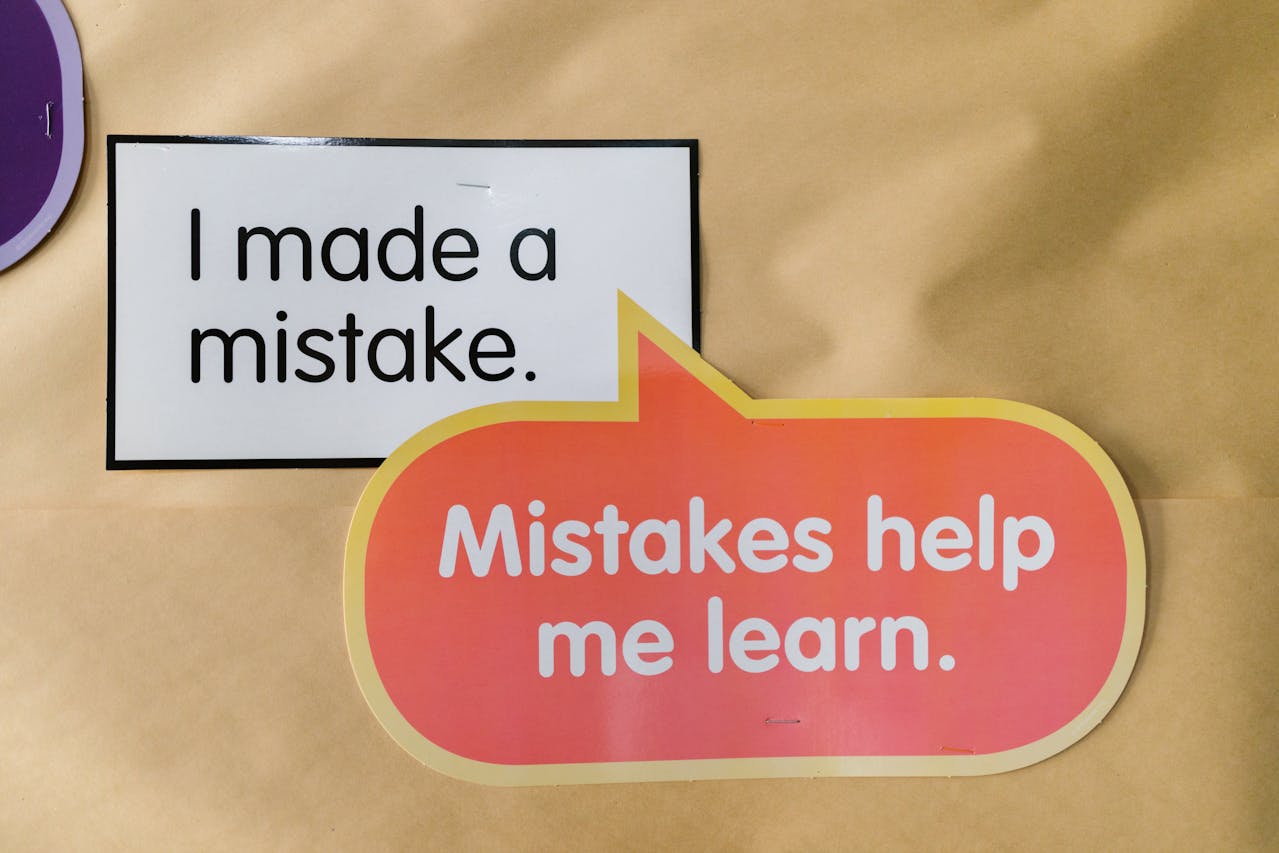Converting visitors into customers gets easier when you use the right lead magnet types at the right funnel stage. It should align perfectly with the needs of the potential buyers based on where they are in the conversion funnel process.
Let’s explore the popular lead magnet types and how you can use them to generate leads at an unimaginable rate.
What is a Lead Magnet?
A lead magnet is a free resource that’s used in marketing to collect the contact information (primarily email addresses) of potential customers. The lead magnet is offered free of cost in exchange for contact information of ideal customers.
Here’s an example of a lead magnet in action:
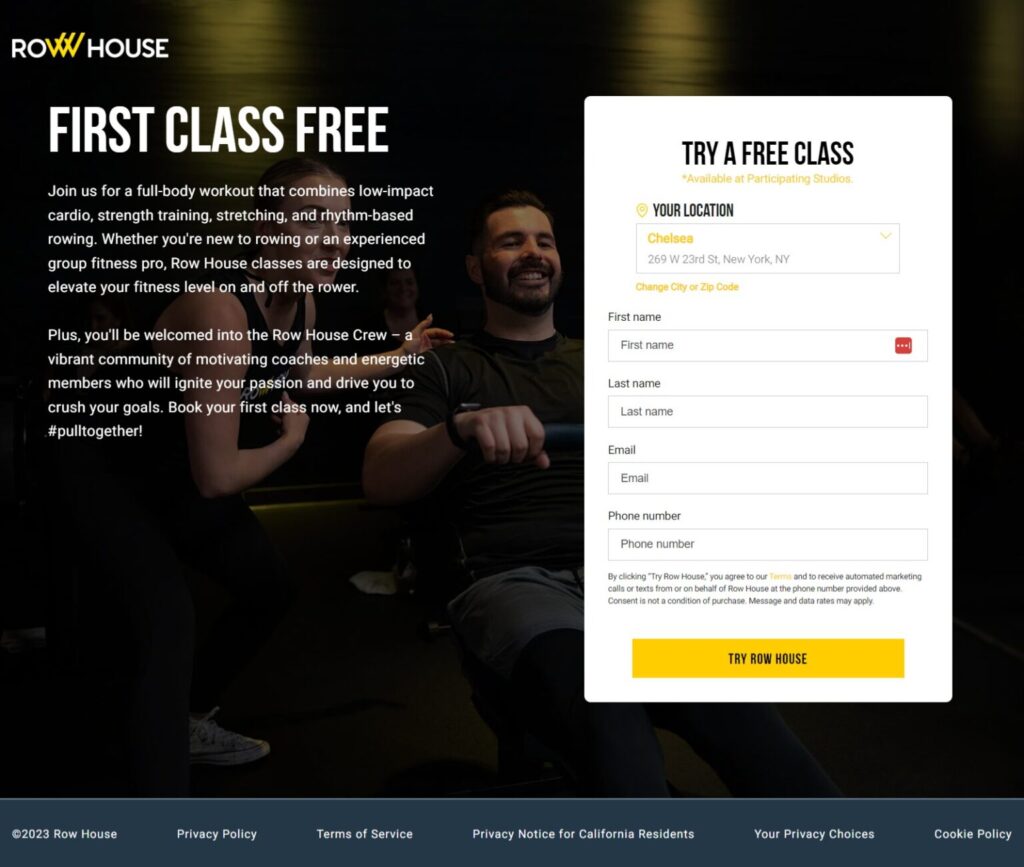
The lead magnet in this case is ‘Free Class’, which is something that potential customers don’t usually get elsewhere. And since it is a free resource, they are more likely to add their contact information to grab this free valuable asset.
This is the whole point of lead magnets – to entice visitors with an offer they can’t resist, so they end up sharing their contact information without hesitation.
It all comes down to how valuable your target audience perceives the free resource to be. If they think it’s not valuable enough for them, they won’t share their contact information.
This is a reason why a lead magnet should be perceived as highly valuable and worth sharing their contact information for.
How a Lead Magnet Works
You know why a lead magnet works, let’s find out how it works to get a better understanding of the whole process.
Here are the exact steps on how a lead magnet works:

- You create a highly valuable asset and offer it free to your target audience
- The lead magnet is offered through a signup page known as a squeeze page
- You send targeted traffic to the squeeze page for conversion
- Visitors who like your lead magnet add their contact information on the squeeze page to get access to the lead magnet
- The lead magnet is delivered via email, and you get a lead (transferred to your CRM tool).
Lead magnets are used to generate leads, which are then nurtured via autoresponders. Here’s an example of how lead magnets are delivered and leads are nurtured:

The idea is to generate leads for your business by offering free resources to your ideal customers and then nurture and convert them.
Lead Magnet Types
Choosing the right type of lead magnet and aligning it with your audience’s needs and sales funnel is essential for success. Here’s a list of the major and popular lead magnet types for you to choose from:
Coupon Codes and Discounts
One of the best types of lead magnets is discount codes that offer instant value to your audience.
Research shows that 88% of people prefer recurring discounts as lead magnets, while 81% are attracted to one-time coupons as a lead magnet:
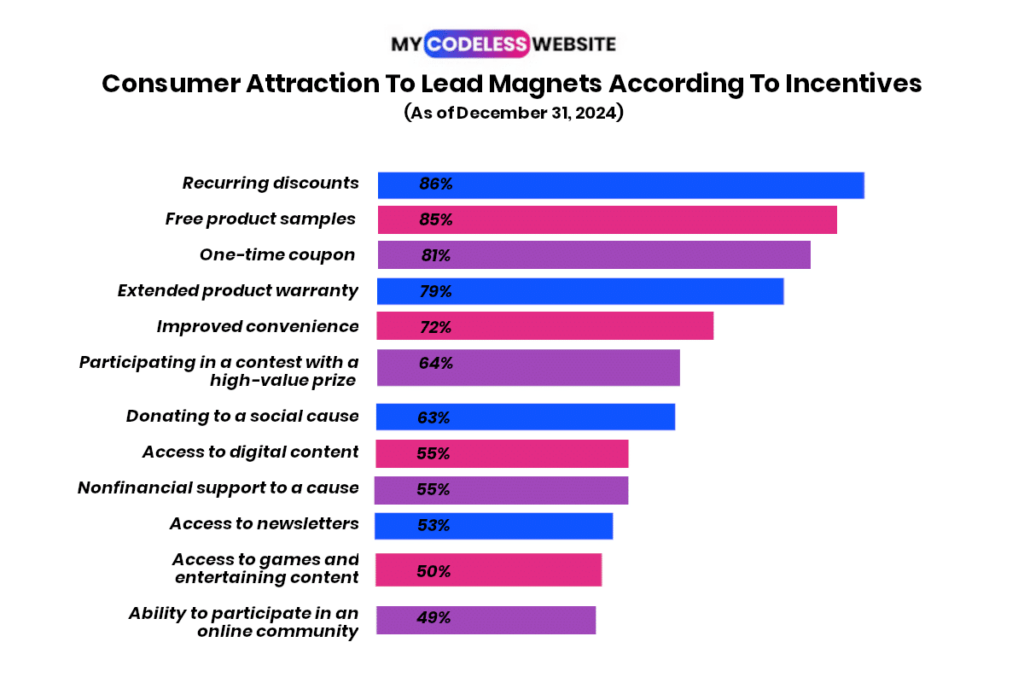
Lead magnets that offer discounts are perceived as highly valuable by consumers. This is because it offers them monetary value and such lead magnets have the highest conversion rates.
Here’s an example of a perfect lead magnet discount offered to new customers:
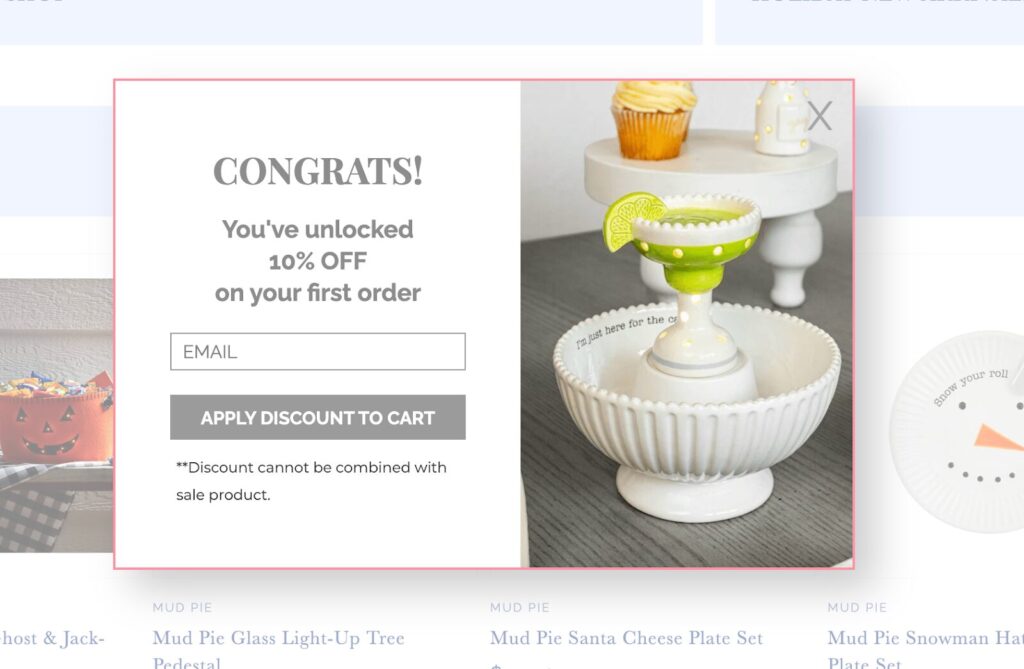
Coupon codes as lead magnets work best for:
- Generating sales
- Acquiring new customers
- Increasing engagement and reorder value
- Promoting cross-sells and up-sells.
Ideally, you should use coupon code lead magnets at the bottom of the funnel to convert visitors into customers. When a potential customer has multiple interactions with your business across multiple channels, a coupon code can turn out to be a deal-breaker.
You can offer discounts in numerous forms such as:
- One-time discounts
- Recurring coupons
- Exclusive discount codes
- Time-sensitive coupons
- Clearance discounts.
Free Shipping
It’s also a type of discount, but since free shipping plays a massive role in the conversion rate of ecommerce stores, it has to be covered separately.
Consumers love free shipping.
As much as 70% of people say they shop online because of free shipping, and 62% of them say that they won’t buy if they aren’t offered free shipping:
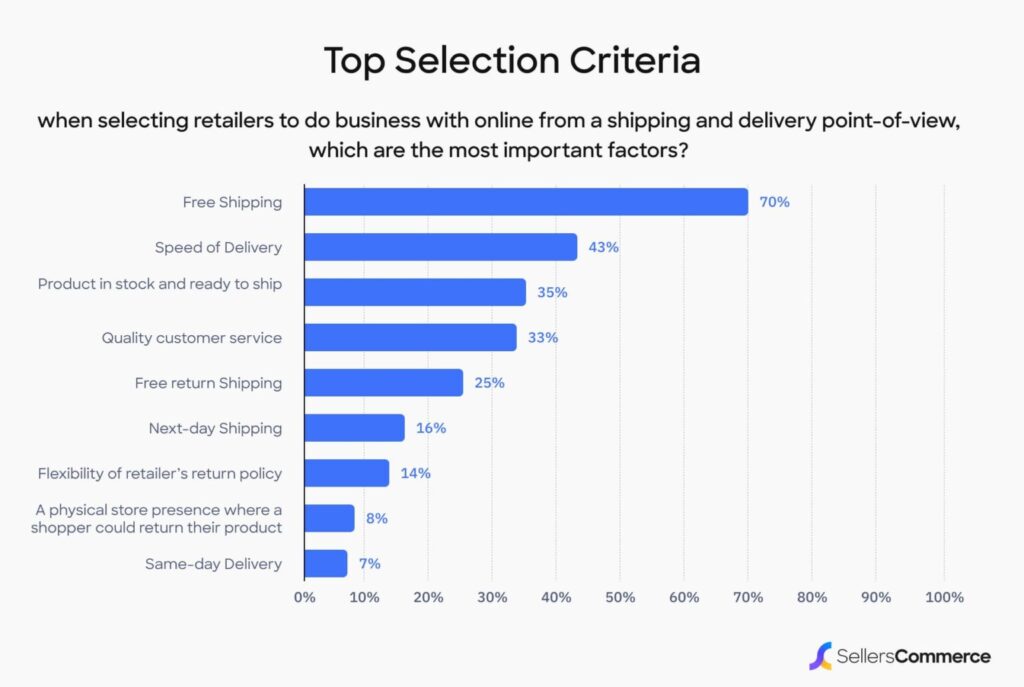
If you offer free shipping lead magnets, you’ll get new leads and sales both.
You need to implement a free shipping lead magnet type smartly.
Make sure you don’t have free shipping enabled as default on your store. If it is, the lead magnet might backfire. You need to have shipping costs enabled and then offer free shipping lead magnets for lead generation and conversions.
That’s how you make it valuable and worth sharing contact information for.
Here’s an example of a lead magnet that offers free shipping. Notice how smartly they have added a timer to create urgency. It’s a perfect way to compel visitors to sign up and place their orders quickly:

You can offer free shipping lead magnets to all the visitors, or you can offer it to visitors who have abandoned carts. It works exceptionally well throughout the funnel.
Product Demos and Samples
Free product samples are the second most important lead magnet type that attracts potential customers, according to 85% of respondents (followed by 86% who like recurring discounts).
Product samples, demos, trials, and other forms of trials work for both physical and digital products. It works equally well for services. You need to figure out a smart and creative way to offer your product’s free trial or demo to your audience so they can’t resist it.
Here’s an example of a free trial offered by a SaaS company as a lead magnet:

Giving access to your product or service to potential customers has two major benefits:
- You are more likely to generate sales and conversions
- This lead magnet type offers high value to your audience as it offers access to a product or service for free.
If you are in the services business, you can offer a free sample of your service to potential clients. For instance, marketing agencies and coaches offer free consultation for a fixed number of minutes as lead magnets.
Here’s an example of a consultancy lead magnet type:
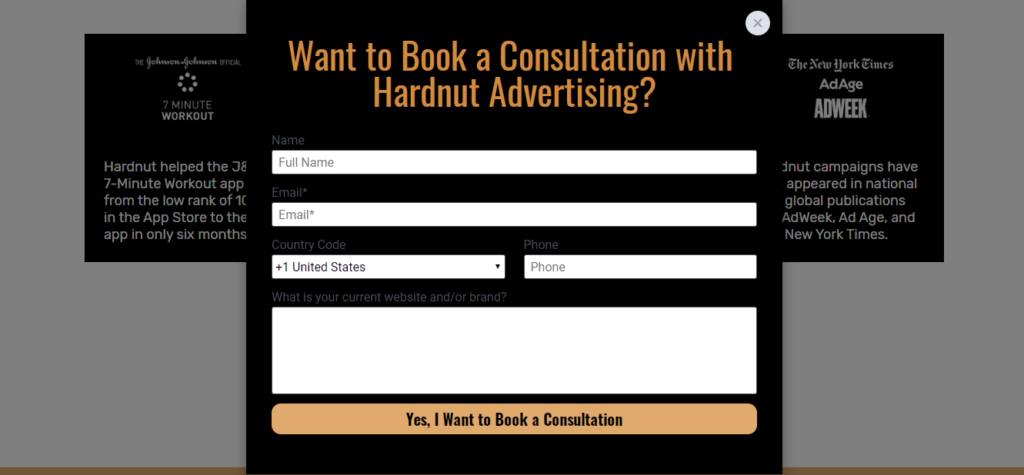
Free product demo lead magnets work for almost all types of businesses and products. You need to come up with an attractive offer with high intrinsic value for your ideal customers.
Guides
Guides and PDFs are among the top lead magnet types as they have the potential to address queries and challenges of your target audience.
A survey of marketing experts found that long-form guides as lead magnets have the highest conversion rate, followed by reports and whitepapers:
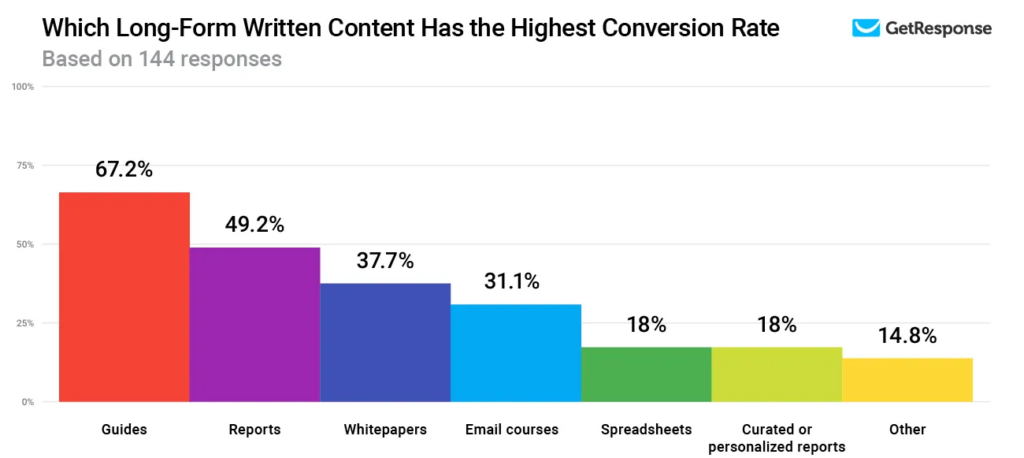
The conversion rate, however, depends on how effectively you have crafted a guide and the value it delivers to the readers. Just because you create a detailed, long-form guide on any topic doesn’t make a great lead magnet.
What’s required is that the guide needs to provide a solution to a common problem your audience is facing.
For instance, how-to guides work best at the top of the funnel, where you have to educate potential customers who are currently unaware of your brand and product. You can hook them with an in-depth how-to guide that addresses a common question in your niche.
And that’s how you can boost the conversion rate. Here’s an example of a guide lead magnet:
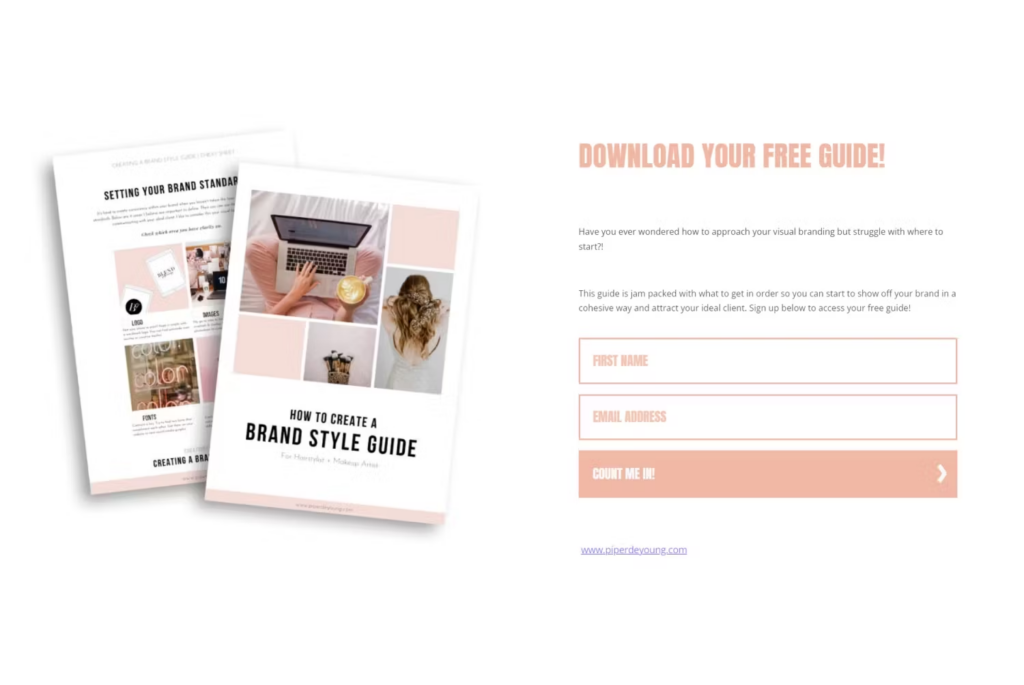
Your guide needs to match the stage of the user in the sales funnel.
For instance, you can create broader guides addressing general queries in your niche for the top of the funnel audience, while you can switch to product-specific guides for the mid and bottom of the funnel audience.
Follow these best practices to write an epic guide for a lead magnet:
- Find a major problem that your audience faces
- Provide more than one solid solution to the challenge in your guide
- The solution should be non-promotional, actionable, and genuine
- Show proof or data of how and why the solution works
- Tweak your guide based on feedback from readers.
White Papers
A white paper is an advanced version of a guide or PDF. It is a more detailed and research-driven report on a specific topic. It’s mostly used at the bottom of the funnel as a lead magnet to establish authority, trust, influence, and convert the audience into customers.
Here’s an example of a white paper used as a lead magnet:
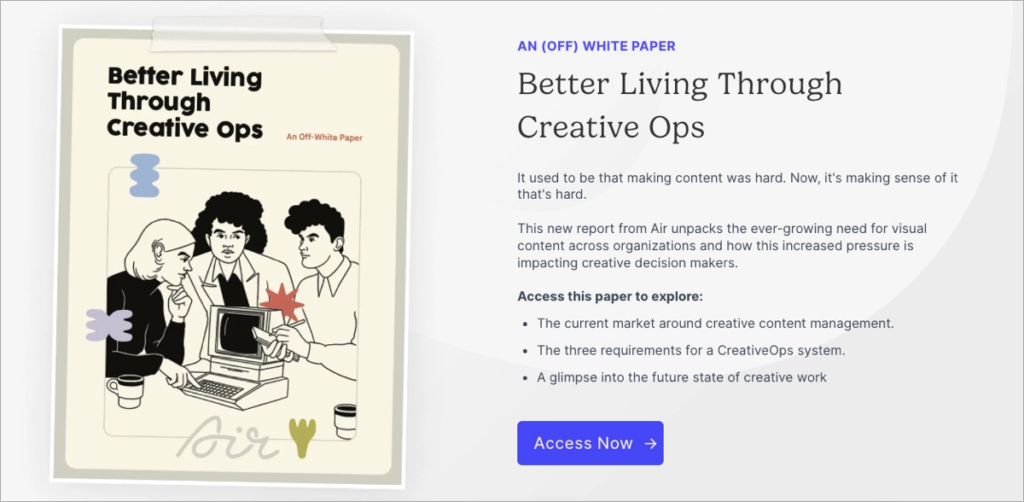
White papers are more common in B2B niches. You should avoid using white papers as lead magnets if you are in the B2C market because most people, in general, don’t know what a white paper is.
Even if an end user knows what a white paper is, the term might not be too appealing for them.
The same goes for reports, which tend to be highly data-driven and based on original research. You can use reports as lead magnets in the B2B market.
Here’s an example of a report lead magnet:
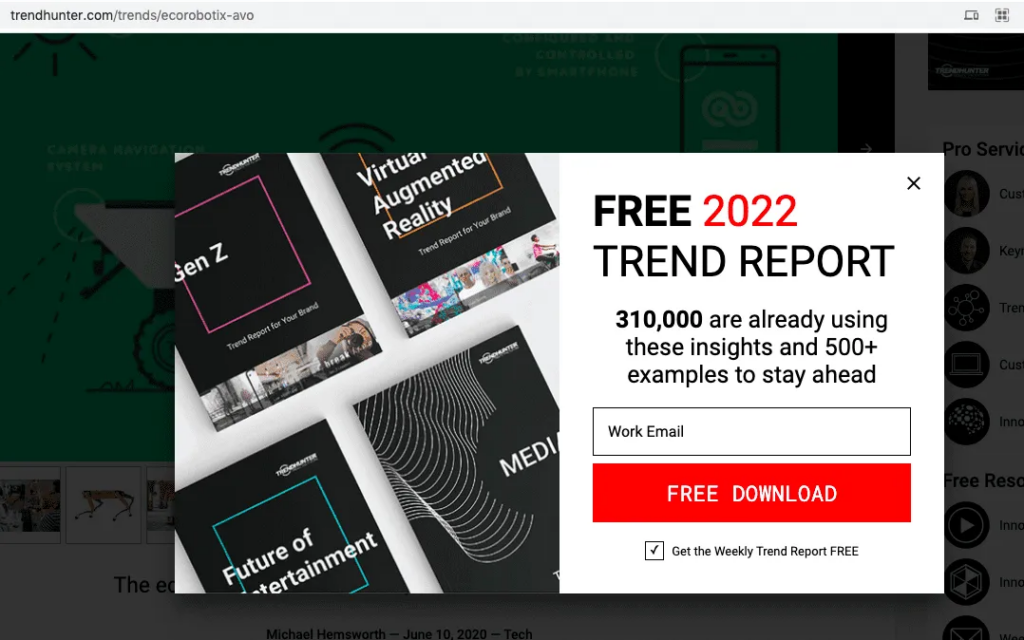
Follow these guidelines to craft high-converting white papers and reports for your B2B business:
- Start with a clear goal and purpose
- Define your audience and the funnel stage you are targeting
- Collect primary data for reports
- Follow the proper layout and format
- Be authoritative and use actionable language.
Webinars
Virtual events, conferences, and webinars offer some of the best and highest quality leads, as reported by 38.1% of marketers.

Webinars are more suitable for B2B audiences and work great at the mid and bottom of the funnel. They provide you with the ability to interact with potential customers and answer their queries. These types of interactive sessions and content are also liked by your audience as they can interact with your brand.
The problem with webinars is that only a small percentage of people show up. The percentage of sign-ups is low, in general. This is because people prefer a lead magnet they can refer to and use at a pace of their choice.
Webinars don’t offer such flexibility.
Secondly, webinars might not be a decent option for the B2C market. It works great for professionals, businesses, and certain target groups.
Having said that, when executed well – a webinar lead magnet can turn the tables. It outperforms other forms of lead magnets by a big margin primarily for two main reasons:
- It offers both visual and audio content that collectively lets you offer lots of value in a short webinar that, otherwise, would take pages of written content
- Interaction between your business and potential customers works both ways – and helps you get to know your ideal customers better (even if the conversion rate turns out to be zero, you’ll still generate tons of data about your audience).
Here’s an example of a webinar lead magnet by SEJ:
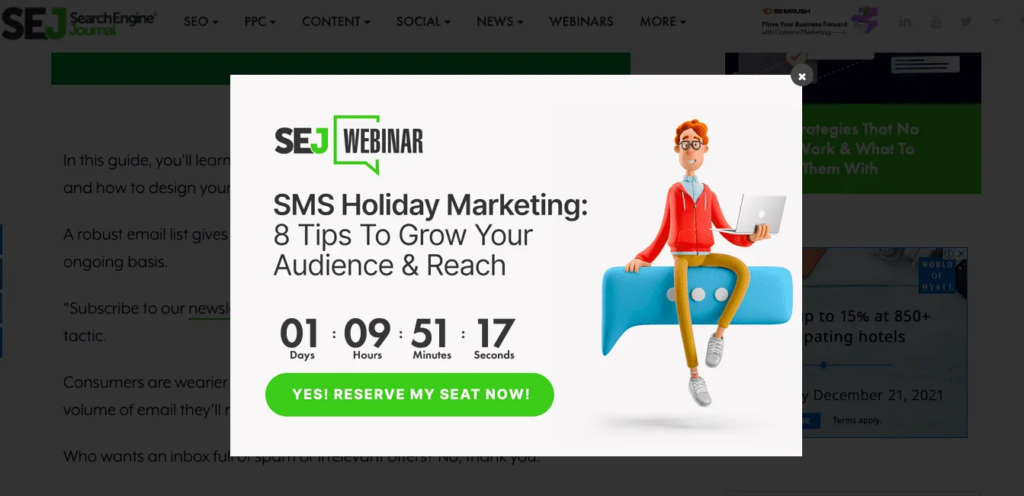
Follow these tips to improve the conversion rate of your webinar lead magnets:
- Choose the right buyer persona for the webinar lead magnet
- Set a clear, well-defined webinar topic that your ideal customers are attracted to
- Keep registration simple and quick
- Engage with your audience and answer their questions
- Keep it professional and authentic
- Let your audience talk. This will help you understand their views and needs
- Record your webinar and share it with your audience.
Interactive
Live webinars aren’t the only form of interactive lead magnet. There are many other lead magnet types you can use to interact with your ideal customers.
These include:
- Quizzes
- Templates
- Surveys
- Tools and calculators
- Challenges.
These interactive lead magnet types have high engagement, conversion rate, and value for end-users. However, interactive lead magnets aren’t as cost-effective as written or other types of lead magnets.
You need to use at least one app to create an engaging, interactive lead magnet.
For instance, you can create a free calculator for your target audience, like a BMI calculator, or calorie counter, or a PDF to text converter tool. The tool or calculator needs to be relevant to your niche and must offer unique value to your audience.
If they can find the same tool or calculator elsewhere without having to share their information, they’ll switch to it.
You need to make your interactive content stand out.
Of course, it’ll cost you a lot of additional resources, but it’ll pay off if executed well.
Here’s an example of an interactive calculator that’s offered free, and additional personalized details are shared after contact information is provided. It’s a smart way to gate the personalized content while keeping the calculator open for everyone. This lets you filter leads:
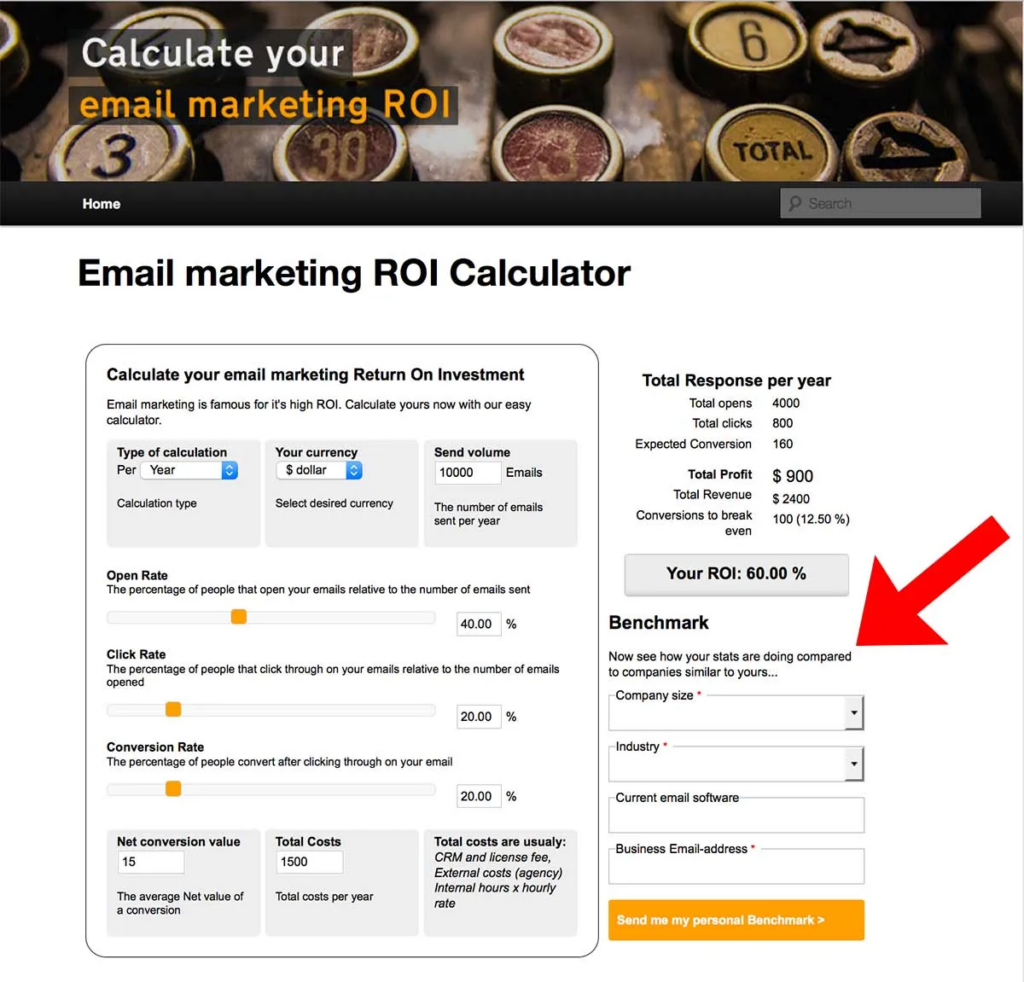
Here’s another example of a gated calculator where you collect the contact information first and then give access to the tool. It’s an equally effective way to generate leads:
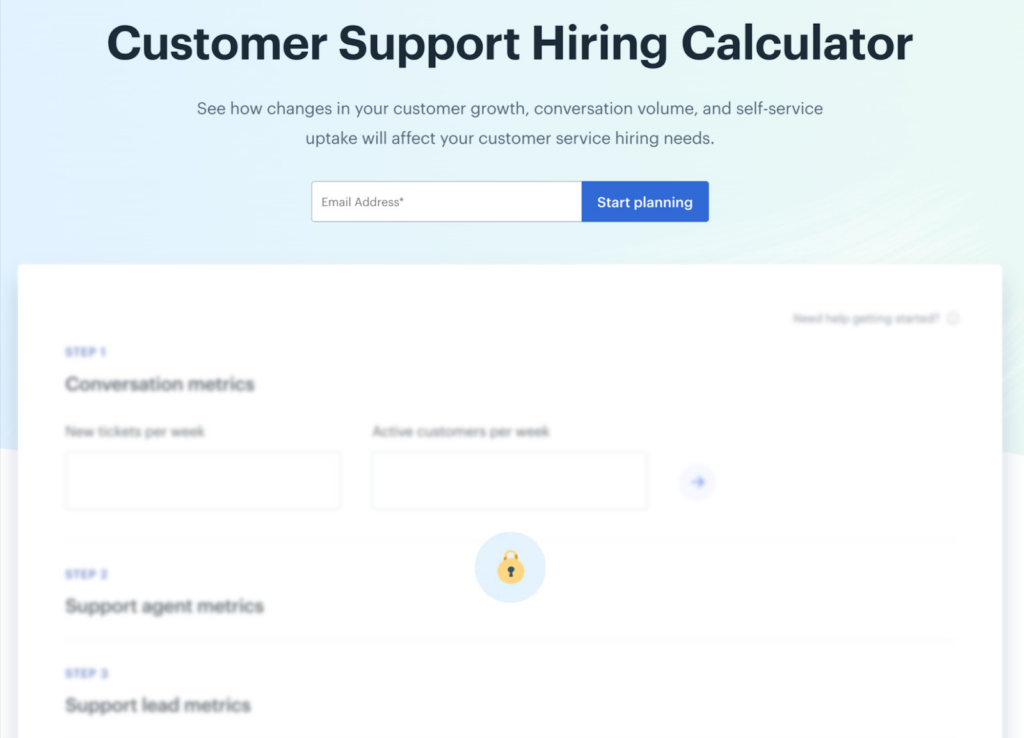
Quizzes, surveys, and challenges are also effective lead magnet types, but they usually work well at the bottom of the funnel (when your audience knows you and is ready to participate in a survey). If you ask a random visitor to participate in a quiz, you might not see a decent conversion or even click rate.
These lead magnet types should be used smartly and must target the right audience based on their previous interaction with your business.
Early Access
It’s a lead magnet type where you make your product or feature available to a certain group before making it public. This exclusive access significantly increases your brand value and credibility.
How?
Your audience assumes your brand and product to be exclusive (or of an exclusive nature). Even those who didn’t opt for the early access would still look at your product differently once released.
Early access creates a sense of exclusivity for the members, which itself is highly satisfying for your audience.
Here’s an example of a lead magnet that uses this approach:

This lead magnet type works best for new products, new product features, or a new brand. The idea is to ensure that the members who opt in get exclusive access to the promised product.
If it’s available openly to your audience via some other channel, it might backfire.
The promised product or feature should be exclusive in the true sense.
Here are a few ideas to create this lead magnet type for your business:
- Wait list
- Beta program
- Exclusive access
- Sneak peek.
Private Group Access
A certain target market in every niche values private groups and access to a closed community where they can interact with like-minded people and the business.
That’s one solid lead magnet type you can use to generate leads.
Here’s an example of a lead magnet that gives you access to a private group:

A study identified 5 reasons why people join private groups:
- Motivation to complete personal goals
- Boost self-esteem
- Lower anxiety
- Reduce uncertainty
- Get protection within the group.
As a business, you need to refer to one or more of these basic needs when creating a private group lead magnet to boost the conversion rate. Describe and explain how your audience can benefit from the community and what they are missing by not being a part of it.
Case Studies
A case study is a detailed, data-driven, and well-researched report that discusses a specific case with its outcomes. It is often used in marketing and business sectors to showcase how a specific marketing or business strategy worked – and how it can be replicated.
Here’s an example of a lead magnet case study:

According to 61% of B2B marketers, case study lead magnets are quite successful in generating and nurturing leads. The primary reason is that case studies provide in-depth analysis of a specific case, which turns out to be quite useful for businesses and professionals.
Case studies, however, should be strictly used for a B2B audience and in niches where it makes sense.
For instance, marketing agencies can showcase their past projects and clients in a case study. This helps you show potential clients how you can help them if they are in a similar situation.
Checklists
A checklist is a perfect lead magnet for a B2C audience. You can pick a common challenge your audience faces, list all the steps to its solution, and create a checklist.
Or, you can create a cheat sheet that lists all the essential information about a specific task.
These lead magnet types are very popular as they provide an instant solution to a problem.
Here’s an example of a checklist:

It is a webinar checklist that simply lists the pre-webinar tasks to be performed. Nothing fancy, but it simplifies a repetitive task.
That’s the whole point of creating checklists – to simplify repetitive, routine tasks.
You can do it across sectors and niches for all types of audiences.
The idea is to make your checklist and cheat sheet very detailed and easy to use. On top of that, it should address a common problem your ideal customers have.
Here’s an example of a checklist lead magnet:

Checklists and cheat sheet lead magnet types work best at the top of the funnel. If you plan to use them for the mid and bottom of the funnel, they might not work too well there unless you incorporate your product into it.
Courses
Videos as lead magnets have the highest conversion rate, according to a survey, as reported by 24.2% of the respondents. Written content has the second-highest conversion rate.
You can incorporate both video and written content in courses and offer them as lead magnets.
Here’s an example of a free course lead magnet:

You can use course lead magnets in several ways:
- Lead generation
- Selling courses
- Authority and credibility.
The best part: You don’t have to create a course from scratch. You can repurpose blog posts and videos to create a course.
Here’s how to do it:
- Find a topic that can be converted into a course
- Create a course outline
- Find relevant blog posts, social posts, videos, and other content you have already published
- Reformat and refine existing content
- Add missing sections and outlines
- Finalize your course.
That’s how easy it is to create a course lead magnet provided you have published tons of content.
If you don’t have a well-established blog, it might not be a decent idea to create a course, as you’ll have to create content from scratch (most of it). In that case, look for other lead magnet types.
Final Words
Lead magnets are crucial for your business. They let you generate leads effortlessly and help grow your company.
The lead magnet types covered above are more than enough to get started.
Choose the lead magnet type that aligns with your business strategy, target audience, and market. If it doesn’t work, change it and try another lead magnet type.
You don’t have to limit yourself to one or two lead magnet types, use as many types of lead magnets simultaneously as possible.
Not all lead magnet types work for all types of audiences and funnel stages. Find the right fit and you’ll see a massive hike in conversion rates.
Featured Image: Unsplash



